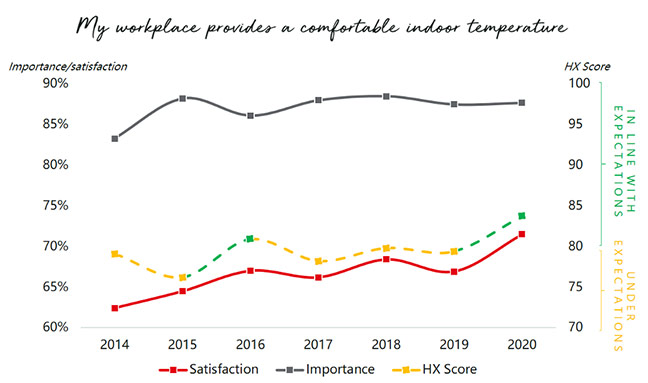Fostering workplace performance through well-being and environmental health

The war for talent and the recent health crisis are driving businesses to place greater emphasis than ever before on their employees’ health and well-being, rethink the ways they work and redesign their office space. Indeed, numerous studies1 point to the key role physical aspects of a building play when it comes to the health, well-being and performance of its occupants. Each year, we learn more and more about the physiological and psychological benefits of natural light, views of nature, air quality2, and acoustic3 and thermal comfort4.
But what do employees “on the ground” think about this in practice? What are their actual expectations when it comes to quality of working life (QWL)? How much do they care about environmental health? Do they also value services dedicated to health and well-being? To what extent does this influence their well-being and productivity at work? And are their expectations currently being met?
Studies that have sought to answer to some of these questions highlight a gap between employee expectations and what offices currently offer. To confirm this trend and give us a better understanding of the issues involved, we commissioned the real estate consultancy JLL to dig into the topic.
Methodology
The study conducted by JLL covers quality of light (natural and artificial), views and green spaces, temperature, acoustics, air quality, and healthy lifestyle services. It examines how important these factors are to office workers and their levels of satisfaction. These factors are also correlated with perceived productivity and well-being.
The study is based on data gathered from a sample of more than 68,000 employees in more than 50 countries. The data is also analyzed based on gender, age group and region. The study also looks at developments over the past seven years.
Key findings:
1) Working environments at the office can be improved:
- Employees attribute real importance to air and light quality, thermal comfort, an absence of noise disturbance, views of the outdoors and green spaces. They also value services dedicated to healthy lifestyles.
- However, their expectations are not entirely met, particularly when it comes to acoustics and temperature.
These findings indicate great potential for improvement in the working environment so that employee expectations are fully met.

Importance vs. satisfaction regarding the quality of the indoor environment and healthy lifestyle services in offices from employees’ perspectives. The HX score is also given for each of the indicators. (Source: JLL.) .5
2) Positive – but insufficient – change over time:
A comparison of data from the past seven years shows an interesting evolution. With the rapid changes in working practices_flex office, home office, employees’ expectations of the office get increasingly high and sophisticated, including with regards to the indoor environment quality. At the same time, we are also seeing an increase in levels of satisfaction, potentially indicating that businesses are paying attention to QWL issues. That being said, even in 2020, there is still way to go before responding fully to employees’ needs.

Changes in HX score (alignment between expectations and satisfaction) for environmental factors and healthy lifestyle services in offices from 2014 to 2020 (source: JLL)

Changes in importance given to thermal comfort in offices from 2014 to 2020 and associated satisfaction levels (source: JLL)
3) Significant differences between genders, generations and regions:
- Women place similar importance to basic needs such as acoustics, temperature, and air and light quality as men do. However, they value experiential factors such as views, green spaces and healthy lifestyle more. Overall, women express notably lower satisfaction levels than men do, particularly when it comes to temperature and air and light quality.
- The factors examined are considered important across all age categories. However, younger generations appear to have the highest standards.
- There are also regional differences. The gap in expectations in terms of air quality, acoustics and temperature is more significant, for instance, for respondents working in Europe and the Middle East.
The report discusses interpretations of the differences observed.

Level of importance vs. satisfaction: differences between men and women (source: JLL)
These findings reveal real differences in expectations, sensitivity and perception among employees. Inclusion is an important challenge for businesses today, and it's crucial to take diversity into account when designing and creating spaces and services.
4) A positive correlation between environmental factors and productivity and well-being:
- Data analysis reveals a positive link between the factors examined and productivity as perceived by employees — with acoustics having the strongest correlation.
- A positive link has also been established between all factors examined and a feeling of well-being. Access to views and green spaces offers the strongest correlation.

Correlation of physical aspects of office spaces and healthy lifestyle services with productivity and well-being (source: JLL)
In absolute terms, the correlation between the factors studied and productivity is not maximal. This outcome confirms that productivity is not determined by one individual factor, but by a combination of many. The same goes for well-being. For instance, factors such as the employee’s relationships with management and their co-workers, quality of IT equipment, and workstation ergonomics undoubtedly have an impact, too.
That being said, the positive link supports the idea that improving comfort and health through an improved working environment would have a real impact on employees’ experience and performance — and the company’s bottom line.
5) A call to action:
In the results presented above, JLL highlights key areas where businesses must prioritize investment to boost the well-being and performance of employees and better meet their expectations. While acoustics and air quality are prerequisites, views and green spaces, light quality, and healthy lifestyle services are areas of strategic focus.

Top and strategic priorities for improving performance and well-being of employees (source: JLL)
Conclusions
While many aspects remain uncertain about employees’ return to work — when, who, how often — one thing’s for sure: their working environment is destined to change. Impeccable hygiene, improved comfort and well-being, varied, flexible spaces, new services — now, more than ever, businesses need to respond to these expectations. However, these requirements did not appear overnight with the emergence of COVID-19. The pandemic only highlighted a trend that had been established for several years.
The study conducted by JLL confirms a reality that other pioneering studies6 had already pointed at. When it comes to indoor physical environments, employees’ expectations include basic needs such as controlled acoustic and thermal comfort, air and light quality, and more experiential needs such as access to views and nature. Employees also hope to see services that will help them feel better and improve their health. However, all these expectations are not yet fully met, despite increasing emphasis on QWL.
There's a direct link between these factors and employee well-being and performance. Taking steps to improve the quality of the indoor environment, combined with services for well-being, not only boosts employee performance – it also makes workers feel more valued, more satisfied and more committed to their work. This can only improve company image and performance in turn.
Ultimately, by putting employees’ needs back at the heart of what they do, companies can create or restore a more human-centric office and ensure it becomes (once again) a pleasant place to spend time, just as we’d wish to find at home. It’s a sure bet for employee and employer alike — and the key to a long-term return to the office post-Covid.
Download the Full Study
- Health, Wellbeing & Productivity in Offices. The next chapter for green building. World Green Building Council, 2013
- Associations of Cognitive Function Scores with Carbon Dioxide, Ventilation, and Volatile Organic Compound Exposures in Office Workers: A Controlled Exposure Study of Green and Conventional Office Environments, J. Allen et al, 2016
- A psychoacoustical approach to resolving office noise distraction, Oseland & Hodsman, 2018
- Quantitative measurement of productivity loss due to thermal discomfort, L. Lan et al, 2011
- The HX score measures the alignment between expectations and satisfaction for a given indicator. A score of 100 is achieved if satisfaction is perfectly in line with expectations. The score increases or decreases for every percentage point of variance between the average importance score and the average satisfaction score.
- The Next 250k, Leesman, 2018